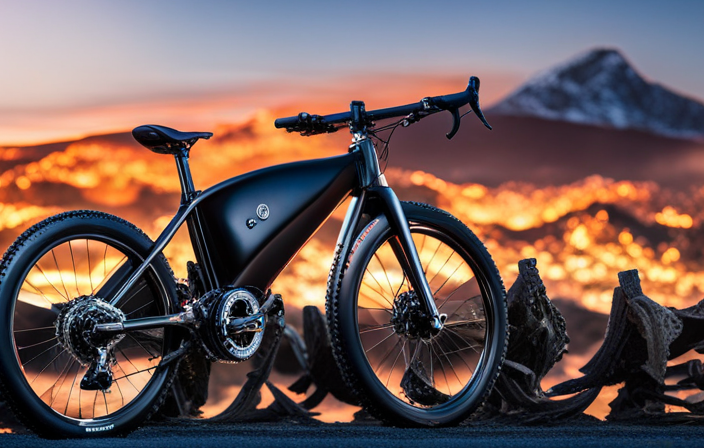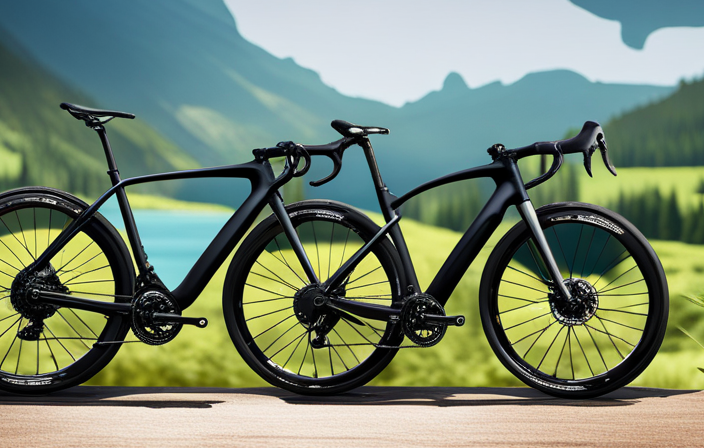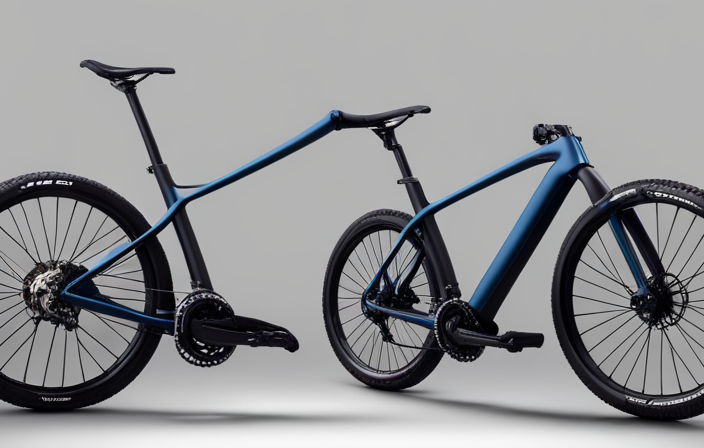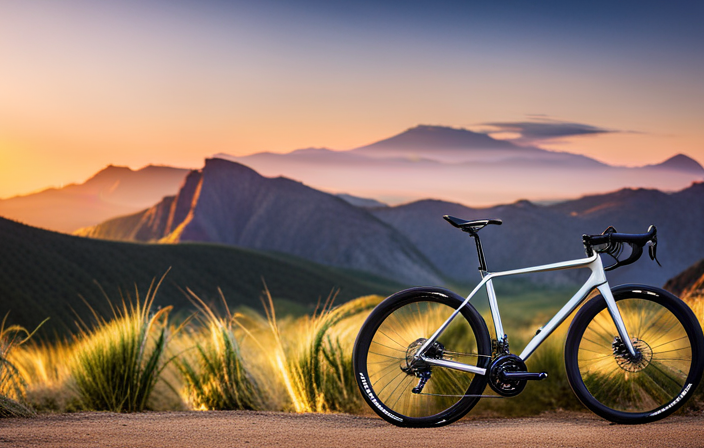Selecting the appropriate rotor size for your gravel bike is a significant decision. Indeed, this choice can profoundly influence both your enjoyment and safety while riding on trails.
With so many factors to consider, from stopping power to heat management, finding the optimal rotor size requires careful analysis. But fear not, fellow riders!
In this article, I will guide you through the technical intricacies of rotor sizing, offering expert tips and recommendations along the way.
So sit tight and get ready to make an informed choice that will elevate your gravel biking adventures to new heights!
Key Takeaways
- Rotor size refers to the diameter of the disc brake rotor, typically measured in millimeters.
- Larger rotors have better heat dissipation capabilities.
- Smaller rotors weigh less, contributing to a lighter bike.
- Consider heat dissipation and weight savings when choosing rotor size.
Understanding the Basics of Rotor Size
The first step in understanding the basics of rotor size for a gravel bike is to know which size is most suitable. Rotor size refers to the diameter of the disc brake rotor, typically measured in millimeters. The two common sizes for gravel bikes are 160mm and 140mm.
One important factor to consider when choosing rotor size is heat dissipation. Larger rotors have a greater surface area, allowing for better heat dissipation. This can be beneficial during long descents or heavy braking situations where excessive heat can cause brake fade. On the other hand, smaller rotors may not dissipate heat as effectively, leading to reduced braking performance over extended periods.
Another factor to consider is weight savings. Smaller rotors weigh less than larger ones, which can contribute to a lighter overall bike weight. This can be advantageous for riders who prioritize speed and agility over maximum braking power.
When deciding on the appropriate rotor size for your gravel bike, it’s essential to take into account both heat dissipation and weight savings. Consider your riding style, terrain conditions, and personal preferences to determine which rotor size will best suit your needs.
Factors to Consider When Choosing Rotor Size
When choosing the appropriate rotor for a gravel bike, it’s important to consider several factors. To ensure optimal performance and safety, one must take into account key aspects such as heat dissipation and weight savings.
Heat Dissipation: A larger rotor size allows for better heat dissipation during long descents or intense braking. This is crucial in preventing brake fade, which can compromise stopping power and overall control of the bike. By increasing the surface area exposed to air, a larger rotor effectively dissipates heat more efficiently.
Weight Savings: On the other hand, it’s important to strike a balance between rotor size and weight savings. While larger rotors offer superior braking power, they also come with added weight. For riders who prioritize agility and responsiveness, opting for smaller rotors can help reduce rotational mass and improve maneuverability on technical terrain.
Personal Riding Style: Finally, your personal riding style should also influence your decision when it comes to choosing rotor size. If you frequently ride aggressively or tackle steep descents, a bigger rotor might be more suitable to handle the demands placed on your brakes.
Considering these factors will allow you to make an informed decision regarding the appropriate rotor size for your gravel bike. Understanding how heat dissipation and weight savings play a role in this choice sets the stage for exploring the relationship between rotor size and stopping power in the next section.
The Relationship Between Rotor Size and Stopping Power
To achieve optimal stopping power, it’s important to understand the relationship between rotor size and braking performance.
When it comes to gravel bikes, choosing the right rotor size can greatly impact your ability to stop quickly and effectively on unpredictable terrain.
One key factor to consider is heat dissipation. Larger rotors generally have better heat dissipation capabilities compared to smaller ones. This is because they have a larger surface area for heat to dissipate from, which helps prevent brake fade during prolonged braking or steep descents.
Another advantage of larger rotors is weight savings. While it may seem counterintuitive that larger rotors could be lighter, advancements in material technology have made this possible. Manufacturers are now able to make larger rotors using lightweight materials without compromising strength and durability.
By opting for a larger rotor size, you not only enhance your bike’s braking performance but also enjoy the benefits of improved heat management and potential weight savings.
In the next section about ‘heat management and rotor size,’ we will delve deeper into how these two aspects work together to optimize your gravel biking experience.
Heat Management and Rotor Size
When it comes to heat management and rotor size, there are two key points to consider.
First, larger rotors provide better heat dissipation. The increased surface area allows for more efficient heat transfer, reducing the risk of overheating during prolonged braking.
On the other hand, smaller rotors offer weight savings. This can be advantageous in disciplines where every gram counts.
Ultimately, finding the right balance between rotor size and heat management is crucial for optimal performance and safety on a gravel bike.
Larger Rotors and Heat Dissipation
If you want better heat dissipation, you should consider using larger rotors on your gravel bike. Heat dissipation is crucial for optimal performance, especially during long descents or intense braking situations. Larger rotors have a greater surface area, allowing them to absorb and dissipate heat more efficiently. This means that they can handle higher temperatures without compromising braking performance. Additionally, the larger size allows for increased airflow around the rotor, further aiding in heat dissipation.
When considering larger rotors for your gravel bike, it’s important to note that they may come with some trade-offs. One potential drawback is the added weight of the larger rotor and corresponding brake caliper adapter. However, this weight increase can often be offset by other weight-saving measures on the bike.
In conclusion, utilizing larger rotors can greatly enhance heat dissipation on your gravel bike, leading to improved braking performance and overall ride quality. Now let’s explore how smaller rotors can provide weight savings without sacrificing too much in terms of heat management.
Smaller Rotors and Weight Savings
Utilizing smaller rotors can provide weight savings without compromising heat management. This is particularly beneficial for gravel bikes, where every gram matters. Smaller rotors have a reduced surface area, which means less material and therefore less weight. However, it is important to consider the impact on heat dissipation and brake performance.
When opting for smaller rotors, it is crucial to ensure that they still offer adequate heat dissipation capabilities. Heat buildup can negatively affect brake performance and lead to diminished stopping power. To address this concern, there are several factors to keep in mind:
- Rotor design: Look for rotors with efficient cooling features such as ventilation holes or fins.
- Brake pad selection: Pairing smaller rotors with high-quality brake pads designed for heat management can help compensate for any potential loss in cooling capacity.
- Riding conditions: Consider the type of terrain you will be tackling as more demanding trails may require larger rotors for optimal braking power.
- Personal preference: Ultimately, finding the right balance between weight savings and brake performance depends on individual riding style and preferences.
Transitioning into the subsequent section about ‘finding the right balance: choosing the optimal rotor size,’ it’s essential to carefully evaluate these factors before determining the ideal rotor size for your gravel bike setup.
Finding the Right Balance: Choosing the Optimal Rotor Size
To find the right balance, you should consider choosing the optimal rotor size for your gravel bike. When it comes to rotor size, there are a few factors to take into account.
One important consideration is heat dissipation. Smaller rotors have less surface area, which means they can dissipate heat less effectively than larger rotors. This could potentially lead to overheating and reduced brake performance on long descents or in demanding conditions.
On the other hand, weight considerations also come into play. Smaller rotors are generally lighter than their larger counterparts, which can be beneficial for riders who prioritize weight savings on their gravel bikes. However, it’s essential to strike a balance between weight savings and heat dissipation capabilities.
Finding the optimal rotor size involves considering both heat dissipation and weight savings. It’s crucial to select a rotor size that provides adequate heat dissipation while still keeping the overall weight of your bike in check. By finding this balance, you can ensure that your gravel bike performs optimally in various riding conditions.
The impact of rotor size on brake performance is a crucial aspect to delve into further as it directly affects how efficiently your brakes will function on different terrains and under varying levels of stress without compromising safety or control.
The Impact of Rotor Size on Brake Performance
In the previous subtopic, we discussed the importance of finding the right balance when choosing the optimal rotor size for your gravel bike. Now, let’s delve into another crucial aspect of rotor size: its impact on brake performance.
When it comes to brake performance, rotor size plays a significant role in heat dissipation and weight savings. A larger rotor has more surface area for heat to dissipate, which can prevent overheating during long descents or intense braking situations. This is particularly important for gravel biking, where you may encounter steep and technical terrain.
Additionally, opting for a larger rotor can also provide weight savings. While it may seem counterintuitive that a bigger rotor could be lighter, advancements in material technology have allowed manufacturers to create larger rotors that are still lightweight without sacrificing strength or durability.
To illustrate the benefits of different rotor sizes, take a look at this table:
| Rotor Size (mm) | Heat Dissipation | Weight Savings |
|---|---|---|
| 160 | Moderate | Average |
| 180 | Good | Better |
| 203 | Excellent | Best |
As you can see from this table, larger rotors offer superior heat dissipation and weight savings compared to smaller ones.
Understanding the impact of rotor size on brake performance is essential for making an informed decision about which size is best suited to your needs. Next, we will explore how rotor size influences cornering and control on your gravel bike…
The Role of Rotor Size in Cornering and Control
Larger rotors significantly impact cornering and control on your off-road cycling. When it comes to navigating tight turns and tricky terrain, the size of your rotor plays a crucial role in maintaining stability and ensuring precise control over your gravel bike.
Cornering techniques heavily rely on the braking performance of your bike, and rotor size directly affects this aspect. With larger rotors, you can expect improved stopping power, allowing you to brake later into corners while still maintaining control. This means you can carry more speed through turns without compromising safety.
Additionally, larger rotors provide better heat dissipation capabilities. As you apply brakes during cornering, friction generates heat that can quickly build up around the rotor area. By having a larger surface area for heat dissipation, bigger rotors help prevent overheating issues that could lead to brake fade or loss of control.
Considering these factors, it becomes evident why choosing the right rotor size is essential for optimal cornering performance and overall control on gravel rides. It’s important to assess your riding style and terrain conditions to determine the ideal rotor size that suits your needs.
Transitioning into the subsequent section about ‘rotor size recommendations for different gravel riding conditions’, we can delve deeper into specific scenarios where certain sizes excel in providing superior performance without compromise.
Rotor Size Recommendations for Different Gravel Riding Conditions
When it comes to choosing the right rotor size for different gravel riding conditions, there are a few key points to consider.
For smooth and flat gravel roads, a smaller rotor size like 140mm may provide sufficient stopping power without adding unnecessary weight.
However, when tackling technical and steep descents, a larger rotor size such as 160mm or even 180mm can offer increased heat dissipation and improved braking performance.
Lastly, for mixed terrain and varied conditions, opting for a mid-sized rotor around 160mm might strike the right balance between control and weight savings.
Smooth and Flat Gravel Roads
On smooth and flat gravel roads, a smaller rotor size may be sufficient for a gravel bike. Choosing a smaller rotor size has its benefits and drawbacks.
The main benefit is that it reduces weight, which can enhance the bike’s overall performance on these types of terrain. A smaller rotor also requires less force to stop the bike, making it easier to modulate braking power.
However, there are some drawbacks to consider. With a smaller rotor size, heat dissipation may become an issue during prolonged braking or on steep descents where more heat is generated. Additionally, a smaller rotor may not provide as much stopping power as a larger one, which could be problematic in emergency situations or when riding at higher speeds.
Transitioning into the subsequent section about technical and steep descents, it becomes crucial to assess the appropriate rotor size for different riding conditions.
Technical and Steep Descents
Navigating technical and steep descents requires careful braking and adaptation to the terrain.
When descending on gravel roads with varying difficulty levels, having the right rotor size is crucial for efficient heat dissipation. A larger rotor can dissipate heat better, preventing brake fade and maintaining consistent performance throughout the descent.
Weight distribution plays a key role in tackling steep descents on a gravel bike. Shifting body weight back and keeping it centered over the bike helps maintain stability and control while going downhill.
Finding the right balance between front and rear braking is important. It ensures that neither wheel locks up or loses traction.
Moving into the next section about mixed terrain and varied conditions, these skills will continue to be essential for a safe and enjoyable ride without skipping a beat.
Mixed Terrain and Varied Conditions
To handle mixed terrain and varied conditions, you’ll need to adapt your technique and adjust your weight distribution accordingly.
When it comes to choosing the right rotor size for these conditions, there are a few factors to consider.
In wet conditions, a larger rotor size can provide better braking power and heat dissipation, helping to maintain control on slippery surfaces. A 160mm or even a 180mm rotor may be suitable in these situations.
On the other hand, for rough terrain with constant vibrations and potential impacts, a smaller rotor size like 140mm may be more appropriate as it reduces the risk of damage from rocks or debris hitting the rotors.
It’s important to find the balance between braking power and durability based on the specific demands of your riding environment.
Now let’s move on to how to measure and install the correct rotor size seamlessly into your gravel bike setup.
How to Measure and Install the Correct Rotor Size
Measuring and installing the correct rotor size for a gravel bike is essential. When it comes to mixed terrain and varied conditions, having the right rotor size can greatly affect your bike’s performance and braking power. To ensure an optimal riding experience, it is crucial to measure the rotor size accurately before installation.
To measure the rotor size, you will need a caliper tool or a measuring tape. Start by removing the wheel from your gravel bike and locating the rotor. Using the caliper tool or measuring tape, carefully measure the diameter of the rotor. This measurement will determine the correct rotor size that you need for your bike.
Once you have determined the correct rotor size, it’s time to install it on your gravel bike. Begin by removing any existing rotors from your wheel hub. Then, align the new rotor with the mounting holes on your hub and secure it using bolts or quick-release mechanisms provided with your brake system.
When upgrading your rotor size, there are several factors to consider such as weight distribution, frame compatibility, and personal preferences. These considerations will help you make an informed decision about whether upsizing or downsizing your rotors is necessary for improved performance on different terrains without compromising safety.
Transitioning into ‘upgrading your rotor size: things to consider,’ it’s important to carefully evaluate these factors before making any changes to ensure optimal braking performance on diverse surfaces without sacrificing control and stability during rides.
Upgrading Your Rotor Size: Things to Consider
Now that we know how to measure and install the correct rotor size for our gravel bike, let’s dive into the topic of upgrading your rotor size.
When considering a larger rotor size, there are a few important factors to take into account.
One crucial aspect is heat management. As you increase the rotor size, you also increase its surface area, allowing for better heat dissipation. This is particularly beneficial when riding on challenging terrain or during long descents that put a significant strain on your braking system. By upgrading to a larger rotor size, you can improve brake performance by reducing the risk of brake fade caused by excessive heat buildup.
Another factor to consider is weight distribution. A larger rotor will distribute braking forces over a wider area, resulting in more even wear on your brake pads and rotors. This helps maintain consistent braking power throughout your ride and extends the lifespan of your components.
By understanding these aspects of heat management and weight distribution, you can make an informed decision when upgrading your rotor size for optimal performance on gravel terrain.
Moving forward into our next section about common mistakes to avoid when choosing rotor size…
Common Mistakes to Avoid When Choosing Rotor Size
When considering the correct rotor for your ride, it’s important to avoid common mistakes that could impact your braking performance. Here are a couple of key points to keep in mind:
-
Measuring rotor size accurately: One mistake many riders make is not accurately measuring their current rotor size before upgrading. It’s crucial to measure both the diameter and thickness of your existing rotor to ensure compatibility with the new one. Using calipers or a measuring tape can help you get precise measurements.
-
The importance of rotor size for braking distance: Another mistake to avoid is choosing the wrong rotor size without understanding its impact on braking distance. Larger rotors provide more surface area for heat dissipation and increased stopping power, while smaller rotors may offer less stopping power but better modulation. Consider factors such as your riding style, terrain, and weight when deciding on the appropriate rotor size.
By avoiding these common mistakes, you can ensure that you choose the right rotor size for your gravel bike and optimize your braking performance.
Now that we have covered how to choose the correct rotor, let’s move on to maintaining and caring for your rotors without compromising their effectiveness.
Maintaining and Caring for Your Rotors
To maintain optimal performance, it’s important to regularly clean and inspect your rotors for any signs of wear or damage. Proper maintenance and care can extend the lifespan of your rotors and ensure smooth operation on your gravel bike. One key aspect of rotor maintenance is measuring rotor wear. Over time, the braking surface of the rotor may become thinner due to friction with the brake pads. By using a caliper or micrometer, you can measure the thickness of the rotor at multiple points to determine if it has worn beyond its recommended limit.
Additionally, troubleshooting rotor noise is another essential part of caring for your rotors. If you notice any squealing or grinding sounds while braking, it could indicate an issue with your rotors. Common causes include contamination from oil or grease, uneven pad wear, or misalignment. Cleaning the rotors with isopropyl alcohol and sanding down uneven surfaces can often resolve these problems.
By regularly maintaining and caring for your rotors, you can ensure they perform optimally and prevent potential issues that may arise from neglecting their upkeep. Now let’s delve into expert tips and recommendations for selecting the appropriate size for your gravel bike’s rotors without compromising performance.
Expert Tips and Recommendations for Rotor Size Selection
If you want optimal performance, it’s important to consider expert tips and recommendations for selecting the right size for your gravel bike’s rotors. When it comes to rotor size selection, there are two key factors to keep in mind: heat management and weight distribution.
Firstly, heat management is crucial for maintaining consistent braking performance on long descents or during intense riding sessions. Larger rotors provide better heat dissipation due to their increased surface area. This helps prevent brake fade by keeping the temperature of the braking system under control. So, if you frequently tackle challenging terrain or ride aggressively, opting for a larger rotor size would be wise.
Secondly, weight distribution plays a significant role in achieving balanced handling and stability. Smaller rotors can help reduce unsprung weight and improve maneuverability, especially when navigating tight corners or technical sections. However, larger rotors offer more stopping power and can enhance overall stability by improving modulation and control.
Considering both these aspects, it’s essential to strike a balance between heat management and weight distribution when choosing the right rotor size for your gravel bike.
In conclusion, selecting the appropriate rotor size requires careful consideration of factors like heat management and weight distribution. Balancing these elements will ensure optimal performance on various terrains. Looking ahead to the future of rotor technology and size options… [transition]
The Future of Rotor Technology and Size Options
As technology advances, the future of braking systems will likely bring innovations in both the design and options available for heat dissipation and weight distribution. These advancements will have a significant impact on braking performance, especially for gravel bikes that require reliable stopping power on various terrains.
One potential advancement in rotor technology is the development of new materials that offer improved heat dissipation properties. Currently, most rotors are made from stainless steel, which can become overheated during prolonged or intense braking. However, future advancements may introduce materials with better thermal conductivity to dissipate heat more efficiently, reducing the risk of brake fade and maintaining consistent stopping power.
Additionally, we may see rotor designs that optimize weight distribution to enhance overall bike performance. By strategically placing weight along the rotor’s circumference, manufacturers can improve stability and control while minimizing rotational inertia. This would result in more responsive braking and improved handling on rough gravel surfaces.
In conclusion, the future of rotor technology holds great potential for enhancing gravel bike braking performance. Advancements in heat dissipation and weight distribution will undoubtedly contribute to safer and more efficient stopping capabilities. With these developments on the horizon, riders can look forward to even greater confidence when choosing the right rotor size for their gravel bikes.
Final Thoughts on Choosing the Right Rotor Size for Your Gravel Bike
When it comes to selecting the appropriate rotor for your gravel bike, consider your riding style and terrain. The size of the rotor plays a crucial role in determining the braking performance of your bike. Larger rotors generally offer more stopping power and better heat dissipation, but they also add weight to the bike. On the other hand, smaller rotors are lighter and may provide sufficient braking power for less aggressive riders or on flatter terrains.
To help you make an informed decision, here is a table that compares different rotor sizes and their characteristics:
| Rotor Size (mm) | Braking Power | Heat Dissipation | Weight |
|---|---|---|---|
| 140 | Adequate | Average | Light |
| 160 | Good | Good | Moderate |
| 180 | Excellent | Excellent | Heavy |
Keep in mind that cornering techniques and braking techniques also play a significant role in how effective your brakes will be. Proper body position, weight distribution, and modulation of braking force are essential skills to master when riding off-road. It’s important to practice these techniques regularly to enhance your control and safety while riding.
In conclusion, choosing the right rotor size for your gravel bike involves considering factors such as riding style, terrain, and personal preferences. By understanding how different rotor sizes affect braking performance, you can make an informed decision that enhances both your safety and enjoyment on the trails.
Frequently Asked Questions
Can I use a larger rotor size on my gravel bike for better stopping power?
Yes, using a larger rotor size on your gravel bike can indeed provide better stopping power. Increasing the rotor size allows for improved heat dissipation, which is crucial during prolonged braking periods.
However, it’s important to consider the impact of rotor size on bike weight and handling. Larger rotors may add weight to your bike, potentially affecting its agility and maneuverability.
Therefore, it’s essential to find a balance between increased stopping power and maintaining optimal bike performance.
How do I know if my current rotor size is too small for my riding style?
Upgrading to a larger rotor size can have its benefits and drawbacks for gravel biking.
Picture yourself riding down a steep, rocky descent. The smaller rotor may struggle to provide enough stopping power, leaving you with less control and potentially compromising your safety.
However, a larger rotor can improve stopping power, allowing for more confident braking.
It’s important to consider the trade-off of increased weight and potential clearance issues when deciding on the right rotor size for your riding style.
Are there any disadvantages to using a larger rotor size on my gravel bike?
Using a larger rotor size on your gravel bike has both advantages and disadvantages.
The advantage is that it provides increased braking power and better heat dissipation, which can be beneficial for long descents or aggressive riding styles.
However, the disadvantage is that it adds weight to your bike, which may affect its overall performance and handling.
It’s important to strike a balance between braking power and weight when choosing the rotor size for your gravel bike.
Can I mix and match rotor sizes on my gravel bike?
Mixing and matching rotor sizes on a gravel bike can have potential impacts on braking performance. It’s generally recommended to use the same size rotors for consistent braking power.
However, using smaller rotors can offer advantages such as reduced weight and increased clearance for wider tires.
It’s important to note that mixing different sizes may lead to uneven braking force distribution, potentially compromising the bike’s stopping power and control.
Therefore, it is advisable to stick with uniform rotor sizes for optimal performance.
How often should I replace my rotors to maintain optimal performance?
To maintain optimal performance of your gravel bike’s rotors, it’s important to consider several factors that affect their lifespan.
Factors such as riding conditions, frequency of use, and proper maintenance can all impact how long your rotors last.
Regularly inspecting them for wear and tear, cleaning them properly, and avoiding overheating are key tips for maintaining their performance.
Remember the adage ‘an ounce of prevention is worth a pound of cure’ when it comes to rotor maintenance on your gravel bike.
Conclusion
In conclusion, finding the right rotor size for your gravel bike is crucial for optimal performance and safety. By considering factors such as terrain, riding style, and heat management, you can determine the perfect balance of rotor size and stopping power.
Remember to maintain and care for your rotors regularly to ensure longevity and efficiency. With expert tips and recommendations, as well as advancements in rotor technology on the horizon, the options are expanding.
So, strap on your helmet, grab your anachronistic wrench, and hit the gravel with confidence!









